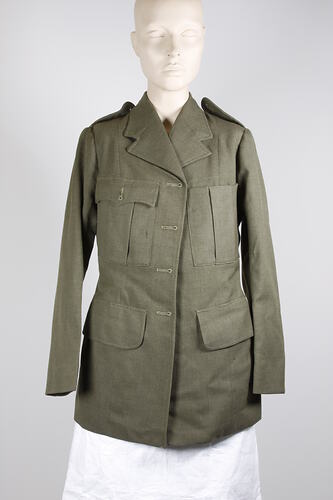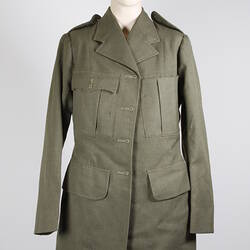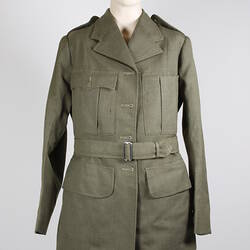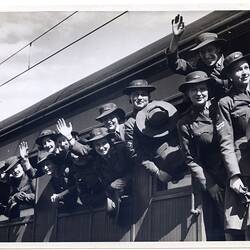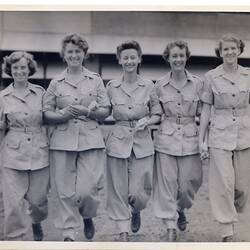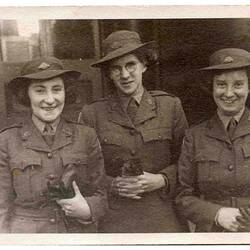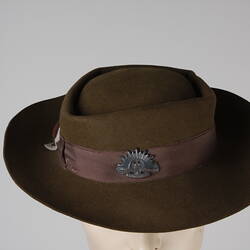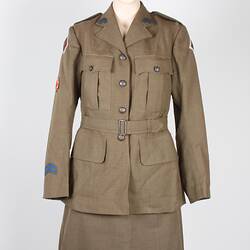Summary
Alternative Name(s): Tunic
Khaki World War II jacket, part of an Australian Army Medical Women's Service uniform. Hat HT 25770 and uniform HT25769 may have been worn or combined with this uniform as needed.
Worn by Alice Isabel Vigor, who was born in 1919 and grew up in Bacchus Marsh. Alice attended Stott's College (established 1883) to learn typing, and saw the war as a chance to leave home and gain her independence. She enlisted on 3 July 1944, and served in the Australian Army Medical Women's Service (service #VFX128592), including overseas service in New Guinea and New Britain. Her family believe she may have driven an ambulance. She met her future husband during the war and married him after her discharge on 25 February 1946. They set up home together in Northcote, where his family lived. They had three children, of whom the donor was the youngest.
In her later years, her family framed her service medals with a photograph of her from World War II. Alice commented that the uniform did not go with the medals, but her meaning was unclear, as the image shows her during World War II, and the medals were awarded to her. The family has retained the framed medals, but lent them to Museum Victoria to be photographed.
The Australian Army Medical Women's Service (AAMWS) was formed in December 1942, mainly from former St John Ambulance Voluntary Aid Detachments (known as VADs), and also including members of the volunteer Red Cross. AAMWS members served as nurses, nursing aides and technicians in hospitals, tending sick and wounded soldiers in the New Guinea, Bougainville, New Britain, Morotai, Borneo and Australia. An AAMWS training school opened in March 1944, and Alice Vigor may well have received the usual seven weeks' training there. Nearly 8,500 AAMWS served in World War II from December 1942. The AAMWS was disbanded in 1951. (Australian War Memorial and Jan Bassett, Guns & Brooches)
The contemporary publication Australia in Uniform, 1943, shows the range of uniform options worn by the AAMWS, including the uniform pieces acquired with this donation. The skirt could be worn with or without the jacket, with a khaki drill shirt and tie. Other uniform options included a khaki cardigan, an 'overall' (a front-buttoned dress), safari jacket and trousers, 'greatcoat', tan kid gloves and a head veil. Sensible brown shoes or boots completed the ensemble. A brown canvas kit bag was also supplied.
Physical Description
Khaki wool jacket, with four button holes down front (missing buttons), with separate waist belt with plain steel buckle. Pocket on each breast, with flap (buttons missing); pocket on each hip, with flaps but without button holes. Badges on collar missing (evidence of where they would have been attached). Shoulders each have an epaulette, again with button missing. Lined with khaki fabric. Cream label at neck. Moth holes throughout.
Significance
This uniform is significant as a rare material record of women's service during World War II. Numerically less significant than men, nevertheless women played many vital roles in the war, both on the home front and in theatres of war. The uniform is from an identified wearer, still alive at the time of donation. The family retains the wearer's medals.
More Information
-
Collecting Areas
-
Acquisition Information
Donation from Jennifer Nathan, 28 Jul 2010
-
Organisation Symbolised
-
Date Used
Australian Army Medical Women's Service, Australia, 1944-1946
Dates refer to dates of service of uniform owner. -
User
Alice Isabel Vigor - Australian Army Medical Women's Service, 1944-1946
-
Inscriptions
On label inside neck, printed: 'V.231 / MADE IN / AUSTRALIA / 1943 / SIZE [blank]'. Written in ink on same label: 'A. VIGOR'. On cloth label stitched to back of belt, written in ink: 'A. VIGOR'.
-
Classification
-
Category
-
Discipline
-
Type of item
-
Overall Dimensions
740 mm (Width), 710 mm (Height)
Height is collar to hem. Width is across hem, and including sleeves. 350mm across shoulders, seam to seam.
-
Other Dimensions
905 mm (Length), 41 mm (Width)
Length of belt includes buckle; width is fabric only
-
References
Australian Army Medical Women's Service (AAMWS) information from Australian War Memorial [Link 1] accessed 3/8/2010. Jan Bassett, Guns and Brooches: Australian Army Nursing from the Boer War to the Gulf War. OUP, 1992 Alfred Festberg (ed), Australia in Uniform 1943 (reproduction), Royal Australian Army Ordnance Corps Museum, 1977 - section 'The Uniform Dress - Australian Army Medical Womens Service'
-
Keywords
